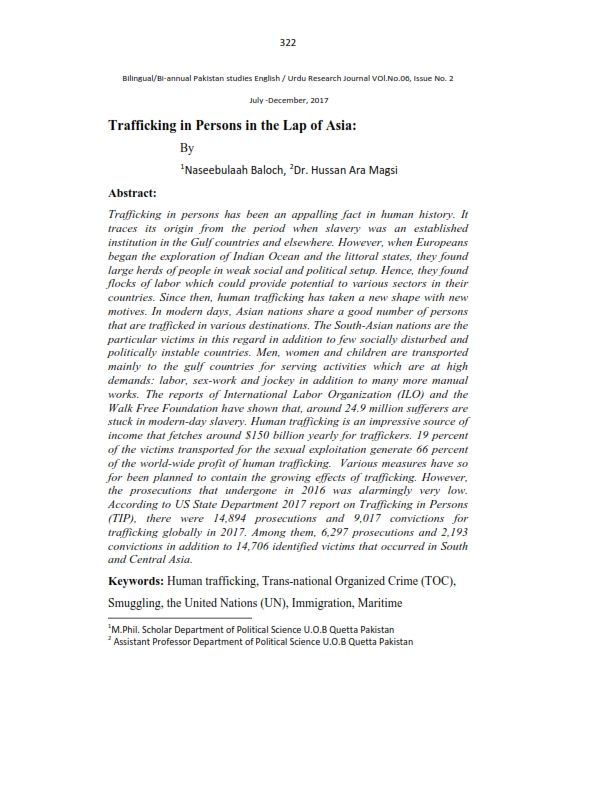Trafficking in Persons in the Lap of Asia
Keywords:
Human trafficking, Trans-national Organized Crime (TOC), Smuggling, the United Nations (UN), Immigration, MaritimeAbstract
Trafficking in persons has been an appalling fact in human history. It
traces its origin from the period when slavery was an established
institution in the Gulf countries and elsewhere. However, when Europeans
began the exploration of Indian Ocean and the littoral states, they found
large herds of people in weak social and political setup. Hence, they found
flocks of labor which could provide potential to various sectors in their
countries. Since then, human trafficking has taken a new shape with new
motives. In modern days, Asian nations share a good number of persons
that are trafficked in various destinations. The South-Asian nations are the
particular victims in this regard in addition to few socially disturbed and
politically instable countries. Men, women and children are transported
mainly to the gulf countries for serving activities which are at high
demands: labor, sex-work and jockey in addition to many more manual
works. The reports of International Labor Organization (ILO) and the
Walk Free Foundation have shown that, around 24.9 million sufferers are
stuck in modern-day slavery. Human trafficking is an impressive source of
income that fetches around $150 billion yearly for traffickers. 19 percent
of the victims transported for the sexual exploitation generate 66 percent
of the world-wide profit of human trafficking. Various measures have so
for been planned to contain the growing effects of trafficking. However,
the prosecutions that undergone in 2016 was alarmingly very low.
According to US State Department 2017 report on Trafficking in Persons
(TIP), there were 14,894 prosecutions and 9,017 convictions for
trafficking globally in 2017. Among them, 6,297 prosecutions and 2,193
convictions in addition to 14,706 identified victims that occurred in South
and Central Asia.
References
Carol Allias, Illicit trade, smuggling and human trafficking, in Potgieter
and Pommerin, Maritime Security in Southern African Waters, Page, 69.
Daily Jung, Ishtiaq Baig, 25 January, 2017.
Dr. Feroz Ahmed, Pakistan: Ghulami ke Pachas sal, Takhleeqat, Lahore,
, page, 113.
http://www.ilo.org/wcmsp5/groups/public/---ed_norm/---
declaration/documents/publication/wcms_081971.pdf
http://www.ohchr.org/EN/ProfessionalInterest/Pages/ProtocolTraffickingI
nPersons.aspx
https://2001-2009.state.gov/g/tip/rls/fs/2005/50940.htm
Institute for security studies, paper, August 2012, NO. 236
Sabelo Gumedze (ed.), The Private Security Sector in Africa, ISS
Monograph Series No. 146, Institute of Security Studies, Pretoria, 2008,
Saff and consultants of the Asian Development Bank , Combating
trafficking of Women and Children in South Asia, Regional synthesis
paper for Bangladesh, India and Nepal, April 2003, Page 48.



